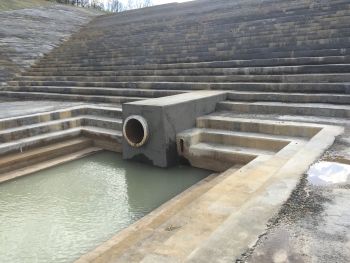Overtopping Protection

|
| Roller compacted concrete (RCC) overtopping protection of the earth embankment dam at Upper Deckers Site 1 in West Virginia. (Photo Source: Gannett Fleming) |
"The original design of a dam may be reevaluated for a number of reasons, including the occurrence of an incident or unusual load, the availability of new information, the refinement of certain design requirements or guidelines, the adoption of risk-based criteria, or as part of a regular dam safety program. During this process, the design flood may be revised, resulting in a flood that is larger than was used for the original design. In many cases, analysis may show that the revised flood will result in the dam being overtopped due to insufficient reservoir storage and/or release capabilities." [1]
"There are many methods available for accommodating larger revised floods. However, some of the more common methods, such as increasing reservoir storage by raising the dam crest or increasing release capability by increasing the spillway discharge capacity, can often be cost prohibitive or impractical. To address this situation, new design approaches have been developed that may allow for the dam to be safely overtopped. The design and construction of overtopping protection for dams is increasingly being viewed as a viable alternative to larger spillways as developing watersheds or changing hydrology produce higher peak flows and the need for additional spillway discharge capacity for existing dams." [1]
"Overtopping protection may be an attractive alternative because of its potential economic advantages and may offer an economical solution to a hydrologic deficiency that would otherwise not be addressed. Maintaining the existing hydraulic conditions at the dam to the extent possible is also increasingly important as downstream river corridors are developed in close proximity to the channel." [1]
"The decision to pursue overtopping protection for an existing dam must give strong consideration to the potential risk of failure of the protection system, which could quickly lead to a full breach of the dam. This is especially true for embankment dams, in the sense that a small defect or design flaw could lead to catastrophic failure once the embankment is exposed to the overtopping flow. An evaluation of this type of risk must be incorporated into the decision-making process, whether qualitatively or quantitatively. A decision to use overtopping protection in place of improving the service spillway, imposing a reservoir restriction, raising the dam crest, or constructing an auxiliary spillway cannot be made lightly. Overtopping protection should generally be reserved for situations with some combination of very low annual probability of occurrence (e.g., 1 in 100), physical or environmental constraints on constructing other methods of flood conveyance, and prohibitive cost of other alternatives; or where downstream consequences of dam failure are demonstrated to be low." [1]
Types of Overtopping Protection
- Roller Compacted Concrete
- Precast Concrete Blocks
- Concrete Slab
- Gabions
- Vegetative Cover
- Turf Reinforcement Mats
- Synthetic Turf Revetments
- Riprap
Best Practices Resources
![]() Technical Manual: Overtopping Protection for Dams (FEMA P-1015), FEMA
Technical Manual: Overtopping Protection for Dams (FEMA P-1015), FEMA
Trainings
![]() On-Demand Webinar: Dam Overtopping Protection Systems Part I
On-Demand Webinar: Dam Overtopping Protection Systems Part I
![]() On-Demand Webinar: Dam Overtopping Protection Systems Part 2
On-Demand Webinar: Dam Overtopping Protection Systems Part 2
Citations:
Revision ID: 7484
Revision Date: 07/28/2023
